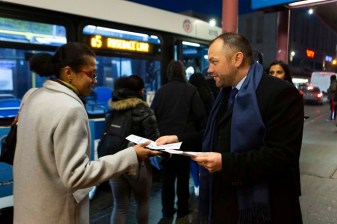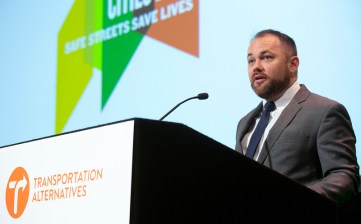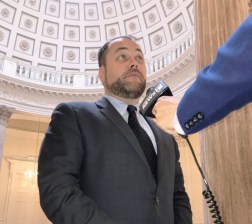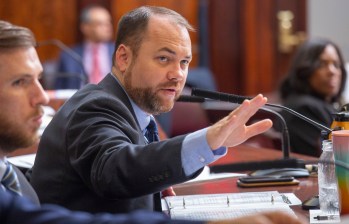Council to Mayor: Do More to Break the Car Culture
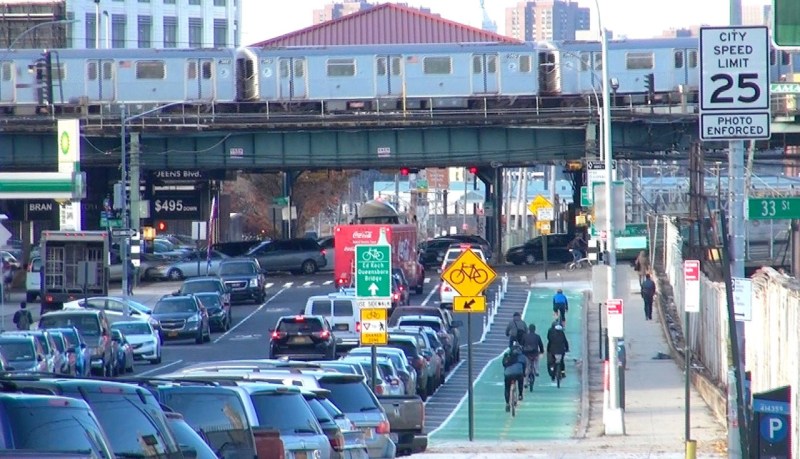
Nice try, Mr. Mayor, but do better.
City Council Speaker Corey Johnson is demanding the de Blasio administration build 50 miles of protected bike lanes, expand an NYPD squad that investigates serious crashes, double the number of public plazas and create more car-free streets — the latest salvo in Johnson’s continued push against the mayor to “break the car culture.”

Such programs are part of the Council’s official response to the mayor’s preliminary budget for the fiscal year that starts on July 1 — a $92.2-billion fiscal plan that offers “few major new initiatives,” the Council’s response sniffs.
In its place, the Council would build on existing programs, and is calling for the city to:
- Expand the NYPD’s understaffed Collision Investigation Squad, which investigates serious crashes yet has only 25 cops assigned to it. The Council wants that team to grow to 40 officers — at a cost of $2.3 million — to “allow for more effective investigations and help find those responsible for fatal and near-fatal accidents.” Full investigation is seen as a key to better enforcement against reckless drivers. The Council would also expand a program that beefs up evidence collection at crashes, currently only a pilot effort out of the Manhattan North command. “Across New York City, only around five percent of … serious injury crashes that occur every year are fully investigated,” the Council document said.
- Install at least 50 miles of protected bike lanes per year towards creating a “fully connected bike network.” “The city’s progress on installing protected bike lanes has been slow-moving and piecemeal, at best, resulting in a disjointed, disconnected system,” the document said. “The Council calls on the administration to significantly increase the installation of this critical, life-saving infrastructure to at least 50-miles per year, by including $40 million annually in the city’s capital budget for protected bike lane installation [and] complete a fully connected bike network by the 2026-2031 Capital Commitment Plan.” Last year, the city installed less than 20 miles of protected bike lane, a decrease from nearly 25 miles the year before, as Streetsblog reported. The city has made an iron-clad commitment only to make double-digit increases in protected bike lanes every year.
- Make the benefits of cycling more equitable. “A lack of bike infrastructure informed by new design standards for true protected lanes in low-income communities of color has left these neighborhoods without critical and lifesaving infrastructure, potentially exacerbating transportation and health disparities overall.”
- Double the size of the Department of Transportation’s pedestrian plaza program, which the Council called “a remarkable success” that is, nonetheless “limited to underutilized roadways and does not consider other publicly owned properties throughout the city. Communities … have no clear path to pursue these low-cost, high-impact partnerships with the city. The scope of the program should therefore be expanded.” As such, the council would allocate $23.8 million — more than double the city’s $11.9 million allocation — “to double the acreage activated by the program by 2022.”
- Create car-free streets, which have “taken a backseat to small-scale and incremental Vision Zero interventions.” Specifically, the Council wants at least one dozen “pedestrianized streets that restrict vehicle access” by 2025. “Members of the Council have begun to identify streets in their districts ripe for pedestrianization, many of which have already tested the elimination of vehicular traffic on a temporary basis.”
- Install more bus lanes, which are “one of the most efficient, cost-effective, and adaptive forms of public transit that the city can pursue.” Johnson wants the city to double its rate of creation of bus infrastructure — and “ensure that every new bus lane should be camera enforced and physically separated from traffic.” Mayor de Blasio has announced his own initiative to improve bus speeds by 25 percent.
- Install special signals that give buses priority at 1,000 intersections per year. The Council is asking the mayor to add $6.3 million to its current signal priority program. The mayor’s budget calls for only 300 signals to be upgraded, at a cost of $2.6 million.
- Add more bike and pedestrian counters at bridges. “Bike counters … allow residents to directly see the impact and results of the agency’s investment in cycling,” the document said, complaining that the city only has one visible bike counter — at the Manhattan Bridge. The Council would allocate $80,000 to add such displays “on all remaining East River Bridges and on the Hudson River Greenway.”
The proposals are already earning kudos from activists.
“The City Council’s proposed budget reflects the dire need of all New Yorkers for deep and comprehensive improvements to our streets — whether in making it safer to walk and bike, fully investigate traffic crashes or bold efforts to speed up our buses, it moves away from the piecemeal efforts we’ve seen too often for too many years,” said Marco Conner, co-deputy director of Transportation Alternatives. “This is very promising.”
The overall Council budget suggestions would cost more than de Blasio’s proposed budget, but the document claims the added money can be found through efficiencies and other cuts.
The document is technically authored by Johnson, Council Finance Committee Chairman Daniel Dromm and Capital Budget Subcommittee Chairwoman Vanessa Gibson, but it very much reflects transportation priorities identified by Johnson in his “Let’s Go” blueprint issued earlier this year at his State of the City address.
In a statement this week, Johnson focused on the budget’s broader picture.
“The budget response points to what this Council’s priorities are, which include investing in our schools, safeguarding our future, promoting budget accountability and protecting New Yorkers,” he said in a statement. “Our main focus is helping New Yorkers, especially those who need it the most.”
Streetsblog reached out to City Hall for a comment and spokesman Raul Contreras sent over this statement:
We look forward to working with the City Council throughout the budget process to build on our success, including collaborating on ways we can grow our historic reserves. We also look forward to evaluating new needs while being mindful of the city’s mandatory savings targets and any economic uncertainty the city faces.

